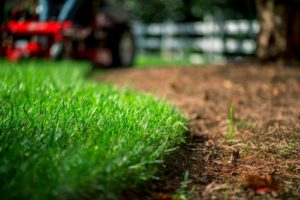Most people don’t notice crabgrass taking over their lawns until summer. This voracious, fast-spreading weed is at its most productive during the warm summer months, growing all throughout lawns and stealing nutrients from the grass that really needs it. By the time you notice it in abundance, chances are it has taken firm hold of your lawn and you’ll need to take an intensive approach to get rid of it.
That’s why you should start looking out for crabgrass earlier. Most of the time, you’ll see a few patches taking root as soon as the temperatures start picking up for the year. The seeds lie dormant all winter, but as soon as the ground temperature is warm enough to support them, they start awakening in earnest.
Preventing Crabgrass
If you get at crabgrass before it starts to germinate, you’ll break the cycle of growth. This means you’ll need to be vigilant as soon as the growing season begins in spring.
And the best way to be vigilant? To have a healthy lawn.
A yard that is vibrant, thriving, and well-cared for creates a difficult place for crabgrass to take hold in the first place. This includes regular (deep) watering, cutting no more than one-third of the grass leaf at a time, and regular aeration/dethatching and other turf care. A nicely tended lawn also makes it easier for you to notice trouble areas as they arise.
Controlling Crabgrass
If you already have a crabgrass problem, it’s not too late. Depending on how far the season has progressed and how much of an infestation you have, you may want to consider the following options.
- Pre-Emergent Herbicide: This herbicide is designed to kill crabgrass seedlings in their early stages of growth. Ideally, it should be applied as soon as the ground temperature reaches 60 degrees—which, for most regions, is fairly early in the spring (as soon as your local trees start budding). Because this herbicide can be rough on newly growing grass, it’s best not to apply this universally over a lawn that has been recently seeded.
- Regular Herbicides: Crabgrass is pretty good at standing up to regular weed killers, including weed & feed fertilizers and anything designed to kill broadleaf weeds. And any other kind of weed killer that is strong enough to kill crabgrass is probably going to be good at killing your regular grass, too. That’s why many homeowners spot-kill crabgrass using a product that allows you to direct where you spray.
- Crabgrass Killers: There are specialty herbicides designed to kill crabgrass. They should be used according to the exact directions on the label. In almost all cases, you want to spray this when temperatures are cooler (lower than 85 degrees) and at a time when you can stay away from mowing, watering, and walking on your property for a few days afterward. Early summer and early mornings are best.
- Non-Chemical Options: If you’d rather avoid chemicals altogether, you can opt to pour boiling water directly on the crabgrass plants or pull them by hand (making sure you get the full root). This is time consuming—and labor intensive—and you’ll need to reseed the area afterward, but you’ll avoid using herbicides this way.
Prevention is the best cure, so come up with a plan of action to keep your lawn lush, green and healthy. By staying on top of lawn care tasks like seeding and aerating, it is possible to stop crabgrass from getting a foothold.







